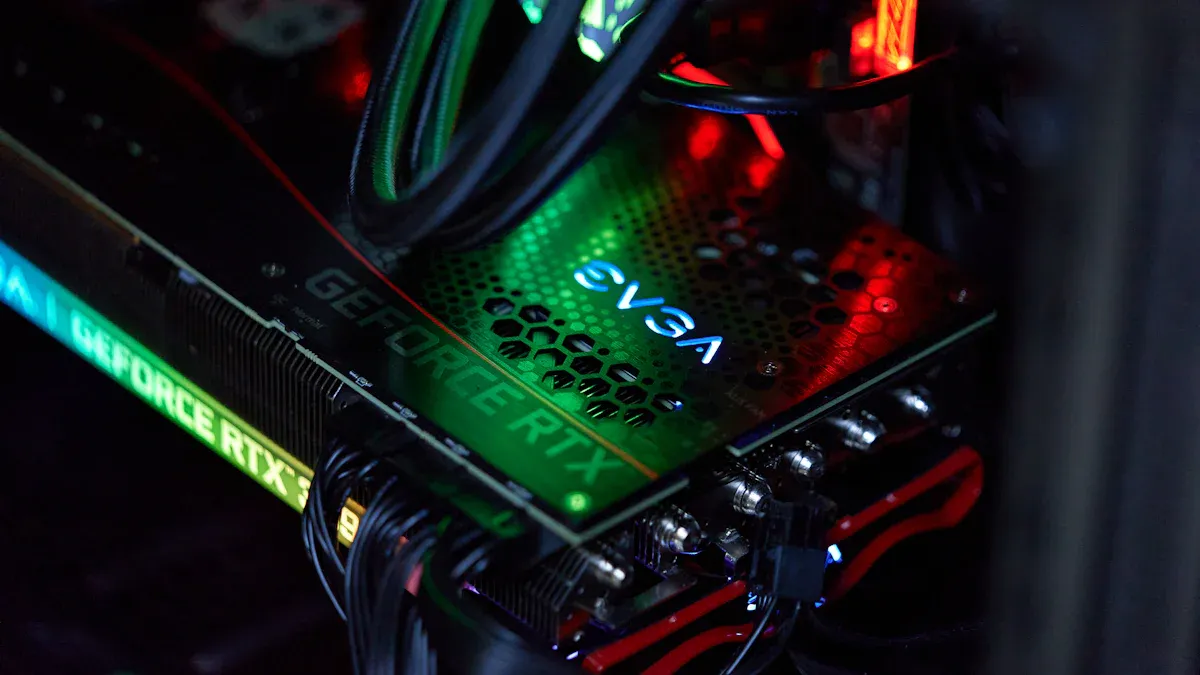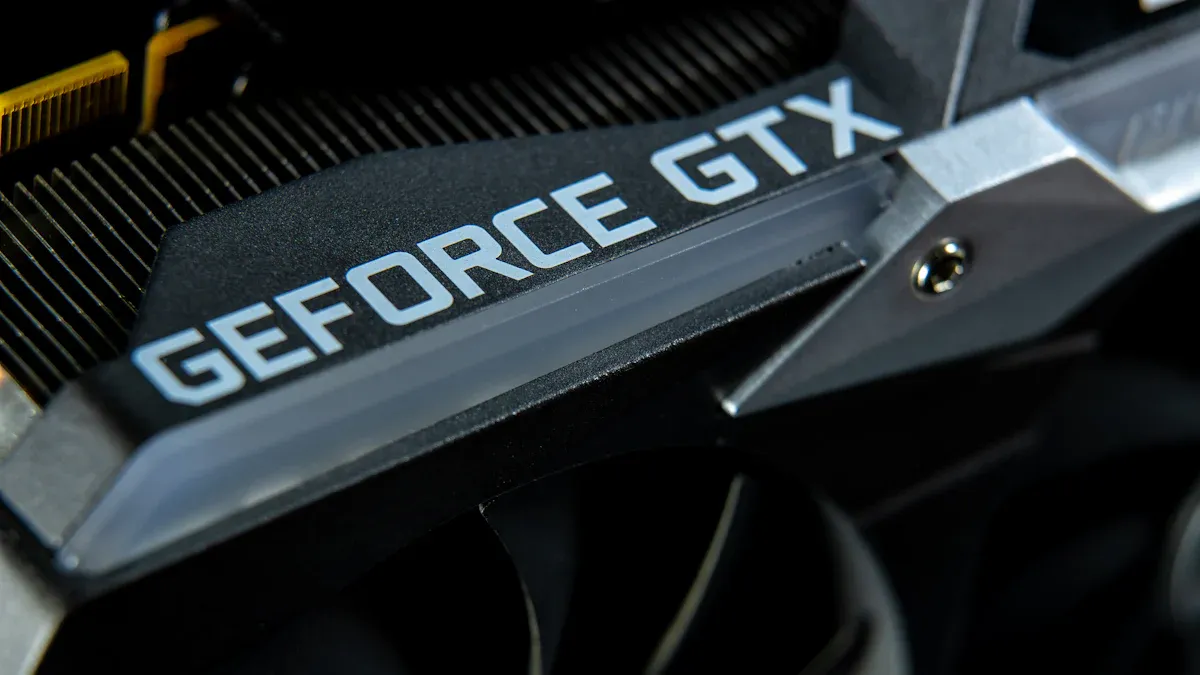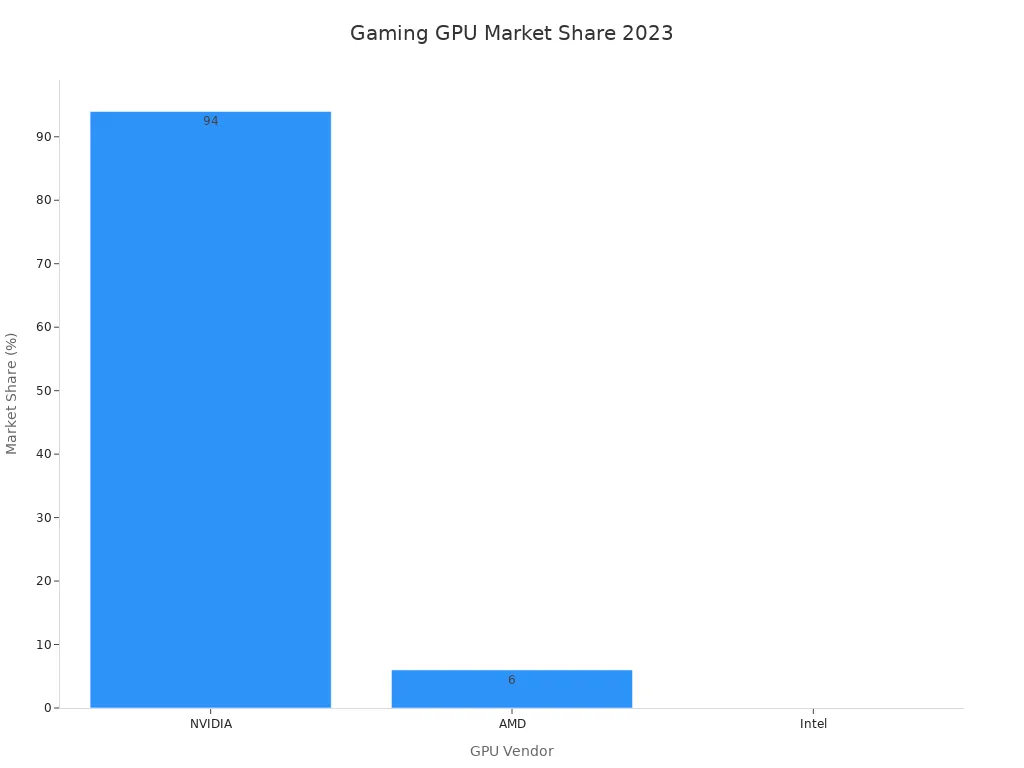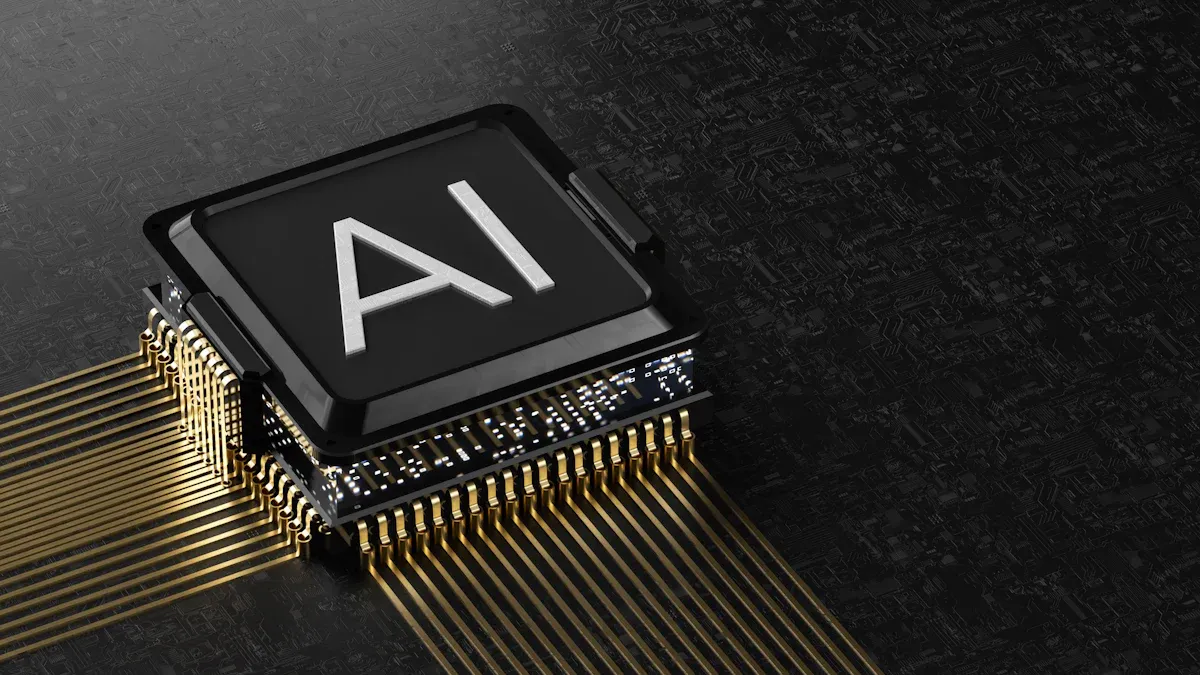How NVIDIA Transformed from Gaming to AI Powerhouse

You see NVIDIA as a top tech company because it changes fast and puts money into new ideas. Today, NVIDIA is worth $5 trillion. This is more than all its main AI rivals together. You notice that AI now makes over $20 billion for NVIDIA. Gaming brings in $8.1 billion in the first half of fiscal 2026. The NVIDIA Case Study shows how good choices can change a business’s future. It can even change where the whole tech industry is going.
Key Takeaways
NVIDIA began as a gaming company. It changed fast to join the AI market. This shows how being flexible and ready for change is important.
The company put money into CUDA technology. This lets GPUs do many jobs at the same time. Doing many jobs is needed for AI work.
NVIDIA worked with big companies like Microsoft and Uber. These partnerships helped it grow into new areas. They also made its AI skills better.
CEO Jensen Huang led with strong ideas. He pushed for new things and teamwork. This helped NVIDIA do well in gaming and AI.
NVIDIA focuses on data centers and AI GPUs. This made it a top company in AI. It shows how smart choices can help a business.
NVIDIA Case Study: Origins And Gaming Roots

Founding And Early Vision
NVIDIA started in 1993. Jensen Huang, Chris Malachowsky, and Curtis Priem created the company. They wanted to change how computers showed graphics. The name "NVIDIA" comes from a Latin word that means envy. The founders wanted to make technology that others would want. Their vision had three main parts:
Make technology that others admire.
Focus on strong graphics solutions.
Help video games and professional graphics needs.
The founders thought graphics would be very important for computers. They worked to make the Graphics Processing Unit, or GPU. This chip helped computers show images and animations better. The NVIDIA Case Study began with a big focus on new ideas.
Tip: If you look at tech history, you see that big ideas can lead to big changes.
Gaming GPU Leadership
NVIDIA soon became a leader in gaming graphics. The company saw that people wanted better graphics for games. In 1999, NVIDIA made the GeForce 256. It was the first GPU. It made games look smoother and more real. In 2001, the GeForce 3 came out with programmable shaders. This let game makers control graphics more.
NVIDIA worked with Microsoft and game studios. They made sure their GPUs worked well with popular games. These partnerships helped NVIDIA grow quickly. You can see their progress in this table:
Year | Milestone/Innovation | Impact on Gaming GPU Market |
|---|---|---|
1993 | Founded NVIDIA | Saw the need for graphics accelerators |
1999 | Made GeForce 256 | First GPU, better visual power |
2001 | Released GeForce 3 | Programmable shaders, better graphics |
2000s | Built partnerships | Better GPU support for top games |
Now, over 3.3 billion people play games every day. In 2023, game sales hit $190 billion. NVIDIA owns more than 90% of the gaming GPU market. You can see how much NVIDIA leads in this chart:

The NVIDIA Case Study shows that a strong vision and smart partnerships can help a company lead an industry.
AI Opportunity And Strategic Shift

Market Trends And Internal Decisions
Technology changes very quickly today. In the last ten years, AI became very important. Companies use AI for things like voice assistants and self-driving cars. You may wonder how NVIDIA saw this coming and made smart choices.
Look at the table below. It shows the big trends that shaped NVIDIA’s decisions:
Trend | Implication |
|---|---|
Geopolitical tensions | Makes things harder for NVIDIA and changes how they get parts. |
Competition from AMD/Intel | Puts pressure on NVIDIA to make new things and keep their spot. |
Strategic expansion into new markets | Helps NVIDIA grow in self-driving cars and industrial AI, with big partnerships. |
U.S.-China trade risks | Brings problems for NVIDIA’s supply chain and market safety. |
Hyperscaler custom silicon | Is a tough challenge but also a chance for NVIDIA to invent. |
Dominance in AI supercomputing | NVIDIA has 92% of the data center GPU market because of strong designs and a big ecosystem. |
NVIDIA faced many problems. The company did not just wait. It made brave choices. Jensen Huang is the CEO. He wanted everyone at NVIDIA to learn and act fast. Here is what the company did to change:
Jensen Huang helped teams stay focused and work together.
NVIDIA took away extra managers. This let teams decide things faster.
The company looked for new markets instead of fighting for old ones.
Teams worked very quickly. They finished jobs as fast as they could.
Jensen learned new things at conferences and brought ideas back to NVIDIA.
The NVIDIA Case Study shows these steps helped the company stay ahead. NVIDIA did not wait for change. It made change happen.
Note: When big changes come, you can learn from NVIDIA. Stay curious, move fast, and try new things.
Early AI Initiatives
You might ask what NVIDIA did first in AI. The company started with big projects and new partners. These first steps made a huge difference.
NVIDIA worked with Uber to help make 100,000 self-driving cars.
The company joined Nokia to help make 6G technology faster.
NVIDIA teamed up with Palantir to build AI agents for government and business.
The company worked with the Department of Energy to build seven AI supercomputers.
NVIDIA made NVQLink, a new way to connect quantum processors and GPUs.
NVIDIA also helped schools and cities:
The University of Utah started an AI factory with NVIDIA. This helped doctors and scientists do better research.
Utah teachers learned AI skills from the NVIDIA Deep Learning Institute.
Rancho Cordova, California, built an AI system with NVIDIA to help the local economy and jobs.
These early actions worked well. NVIDIA’s revenue reached $41.1 billion in the second quarter. Revenue went up 5% in one quarter and 56% in one year. You can see how fast NVIDIA grew after starting with AI.
Metric | Value |
|---|---|
Second-quarter revenue | $41.1 billion |
Revenue growth (quarter) | Up 5% |
Revenue growth (year) | Up 56% |
The NVIDIA Case Study teaches us that taking risks and starting early can bring big rewards. When you see a new trend, you can act fast and help shape the future.
Key Innovations Driving Change
CUDA Technology
You might ask how NVIDIA became a leader in AI. CUDA technology was a big reason for this change. CUDA lets GPUs do more than just show graphics. With CUDA, computers can do many jobs at once. This is great for AI because it needs fast data work.
Here is a table that shows how CUDA helps AI:
Performance Improvement | Description |
|---|---|
Accelerated Data Processing | CUDA makes data move faster, which is important for AI. |
Reduced Latency in Computations | Lower latency means AI can answer more quickly. |
Handling Large-Scale Parallel Tasks | CUDA helps manage many tasks at the same time, which AI needs. |
In 2012, AlexNet used two NVIDIA GeForce GTX 580 GPUs. This neural network started the modern AI revolution. It showed GPUs were much faster for deep learning. It also proved GPUs were needed for AI to grow. Because of this, CUDA became the main tool for deep learning.
CUDA lets developers write code that uses thousands of GPU cores. This makes AI jobs much faster. NVIDIA made sure tools like TensorFlow and PyTorch work well with CUDA. The NVIDIA Case Study shows that investing in CUDA early helped NVIDIA lead in AI.
Data Center Expansion
Another big change was NVIDIA’s focus on data centers. Data centers are places where lots of computers work together. They handle huge amounts of information. NVIDIA’s data center business grew very quickly after the AI shift.
NVIDIA's data center revenue went up 73% in the last quarter.
Almost 89% of NVIDIA's total revenue came from data centers.
The company’s stock price jumped over 940% in three years. This was mostly because of data center needs.
NVIDIA made strong GPUs for these data centers. This helped companies run AI models and process data very fast. The NVIDIA Case Study proves that focusing on data centers was a smart choice. These changes helped NVIDIA and changed the whole tech world.
Leadership And Culture
Jensen Huang’s Impact
Jensen Huang helped shape NVIDIA’s story in a big way. He started NVIDIA in 1993 with two others. He saw how computers would change before most people did. His ideas made big changes in technology. Many people call him the best CEO in the world. He won the Robert N. Noyce Award, which is a top prize in chips.
Jensen Huang made choices that helped NVIDIA get bigger:
Evidence | Description |
|---|---|
Founding NVIDIA | In 1993, Huang started NVIDIA and focused on gaming. He could see what was coming next. |
Introduction of GeForce 256 | In 1999, he helped launch GeForce 256. This changed 3D graphics for everyone. |
Development of CUDA | Huang wanted CUDA, so AI and deep learning could run on GPUs. |
Strategic Acquisitions | He led NVIDIA to buy Mellanox Technologies and tried to buy Arm. This kept NVIDIA ahead. |
Leadership Philosophy | Huang likes taking risks, learning from mistakes, and building teams with many skills. |
Huang always tells people to dream big and aim high. He wants his teams to keep going, even after problems. He thinks new ideas come from trying new things and not being scared to fail.
Tip: If you lead with big ideas and courage, your company can grow and change.
Innovation Mindset
NVIDIA has a culture that helps people share new ideas and learn fast. The company lets everyone talk about what they know. Workers learn together in groups, so everyone gets better.
NVIDIA does not have too many bosses. This means everyone can share their thoughts, no matter their job. People get the same information, so they trust each other. Leaders want workers to think in new ways and try new things.
NVIDIA’s culture is open and helps people learn together.
Workers feel free to share their ideas.
Leaders want people to work together and do their best.
There is a big focus on creative thinking and trying new things.
This way of thinking helps NVIDIA stay ahead when technology changes. You learn that if you work where new ideas matter, you can change and win.
Product Evolution And Ecosystem
AI-Focused GPUs
You may think of NVIDIA for gaming cards, but it also makes special GPUs for AI. These AI GPUs are not the same as gaming GPUs. They help train big AI models and handle lots of data. The table below shows how they are different:
Feature | Gaming GPUs (e.g., RTX series) | AI-focused GPUs (e.g., A100) |
|---|---|---|
Architecture | Optimized for gaming and creative tasks | Engineered for high-performance computing |
Tensor Cores | Limited or absent | Present, optimized for AI tasks |
Memory Capacity | Moderate | Massive, supports large datasets |
Memory Bandwidth | Standard | High, crucial for deep learning |
Intended Use Cases | Gaming, 3D rendering, simulations | AI workloads, model training |
CUDA Support | Yes, for gaming applications | Yes, for diverse computing tasks |
AI GPUs like the A100 have more memory and move data faster. They use tensor cores to help with deep learning. You can train bigger models and get answers faster. These GPUs work for many AI jobs, not just games or pictures.
Tip: To do AI work, you need a GPU made for high-performance computing, not just for games.
DGX Systems And Software
NVIDIA builds DGX systems, which are strong computers for AI research and business. You get fast chips, lots of memory, and special software in one box. Here is why DGX systems are special:
Feature | Description |
|---|---|
AI Performance | |
Hardware | NVIDIA GB10 Grace Blackwell Superchip, ConnectX-7 networking, NVLink-C2C |
Memory | 128GB of CPU-GPU coherent memory |
Software | Pre-installed NVIDIA AI software stack |
Ecosystem | Access to models, libraries, and microservices |
“DGX Spark lets us use very strong computers at our desks,” said Kyunghyun Cho, professor at NYU Global AI Frontier Lab. “This new way to do AI research helps us test and try new AI ideas fast — even for private and safe uses, like healthcare.”
DGX systems help you in many ways:
Scalability: You can use many GPUs together for big jobs.
Ease of Use: The system comes with AI software, so you can start fast.
Flexibility: You can use DGX at your place or connect it to the cloud.
OpenAI used DGX systems to train GPT-4. This helped them test ideas and get better results quickly. When you use DGX, you join a group that helps you grow in AI.
Strategic Partnerships And Growth
Microsoft Collaboration
NVIDIA works with Microsoft to make AI better. This partnership mixes strong hardware with smart software. Microsoft uses NVIDIA’s AI chips in its cloud, like Azure. You get faster AI models and better results for work and research.
Company | Contribution |
|---|---|
NVIDIA | Made BioNeMo for machine learning in biopharma. Worked with Novo Nordisk to build custom AI models. |
Microsoft | Created AI models to predict heart risks. Built BioEmu to study how proteins move. |
These tools help people in healthcare and science. You can use Microsoft’s cloud to run NVIDIA’s AI models. This makes your work quicker and more exact. Many companies use these services to solve tough problems.
Tip: Using cloud AI gives you strong tools. You do not need your own supercomputer.
Industry Applications (e.g., BMW)
NVIDIA’s AI helps many industries grow fast. BMW uses NVIDIA’s Omniverse to change how it builds cars. Teams at BMW work together in real time from different places. They design and change factories with 3D models. This way of working makes planning 30% faster.
BMW uses synthetic data to train AI. This lets them test ideas before building anything. New car models reach the market faster. BMW’s leaders say Omniverse makes planning flexible and exact.
Other companies use NVIDIA’s AI for health, government, and cars. Eli Lilly uses AI to find new drugs faster. The U.S. Department of Energy builds supercomputers with NVIDIA for science and safety. These partnerships help you get better products and services.
Partnership/Investment | Description | Impact |
|---|---|---|
OpenAI | Grew AI infrastructure and market reach | |
Nokia | Works with NVIDIA on 5G and 6G networks | Improved telecom technology |
Oracle | Builds AI supercomputers with NVIDIA | Supports government and research projects |
AWS, GCP, Microsoft Azure | Uses NVIDIA GB200 systems | Expands cloud AI services |
NVIDIA’s partnerships make AI stronger and more helpful. These collaborations help you get new technology faster and improve your life.
Overcoming Challenges
Competition And Market Risks
NVIDIA has many tough rivals as it grows in AI. The company faces new rules and strong competitors. It also deals with changes around the world. In 2022, the U.S. government stopped NVIDIA from selling its best AI chips to China. This ban put $400 million in sales at risk every quarter. NVIDIA quickly made new chips for China, like the A800 and H800. When more bans came in 2023, NVIDIA looked for new places to make chips. They chose the U.S. and Korea. This helps the company avoid problems from world tensions.
Here is a table that shows some big challenges and how NVIDIA responds:
Challenge | Description |
|---|---|
US Export Controls | Bans on top AI chips to China, risking big sales. |
Response | Created new chip models for China, explored new manufacturing sites. |
Supply Chain Diversification | Sought chip production in the US and Korea to reduce risk. |
NVIDIA also has strong competition. AMD tries to win customers with its MI300X GPU. This chip has lots of memory. Intel sells Gaudi chips for people who want to save money. Big tech companies like Google and AWS make their own chips. Startups like Cerebras and Graphcore build chips for special jobs. NVIDIA answers by making new products quickly. It builds strong software and offers full solutions.
Competitor | Strategy |
|---|---|
AMD | High-memory GPUs for large AI models |
Intel | Cost-focused AI chips |
Tech Giants | In-house chips (Google TPUs, AWS Trainium) |
Startups | Niche AI hardware (Cerebras, Graphcore) |
NVIDIA's Response | Fast product launches, strong software, full-stack solutions |
Note: You can see that staying ahead means moving fast and always improving.
Scalability Strategies
You might wonder how NVIDIA keeps up with so much AI demand. The company uses smart ways to grow and help more customers. NVIDIA built Dynamo, an AI orchestration layer. Dynamo helps you use GPU power better and makes AI work faster. The company lets partners and OEMs add NVIDIA AI to their own products. This spreads AI to more places without fighting for each customer.
NVIDIA designs AI factories for quick training and use of AI models. These factories change how businesses use computers. The company makes its AI hardware the same for everyone. This helps partners trust and use NVIDIA technology.
NVIDIA’s AI orchestration layer, Dynamo, boosts GPU use and speeds up AI.
OEMs and partners can add NVIDIA AI, helping more people use it.
AI factories make training and using AI models faster and cheaper.
Standardized hardware gives partners confidence to adopt NVIDIA solutions.
NVIDIA also makes products like the air-cooled RTX PRO server. This helps regular businesses start using AI. You do not need a special data center. You can add AI to your work with less cost and trouble.
Tip: When you make your technology easy to use and share, you help more people join the AI revolution.
Impact And Industry Leadership
AI Industry Influence
NVIDIA is important in almost every part of AI. The company does more than just make chips. It helps other companies use AI in new ways. In mobile networks, NVIDIA works with Cisco. They built an AI-RAN stack for mobile networks. This brings AI into telecommunications. It helps companies move from 5G to 6G. Networks become faster and safer because of this. NVIDIA’s ideas help many industries get better.
NVIDIA also works with Spectro Cloud. This partnership makes AI easier for businesses. The PaletteAI platform uses NVIDIA’s technology. It helps companies use their GPUs better. Before, companies used only 30% of their GPU power. Now, they can use up to 60%. This saves money and gets more work done. NVIDIA’s work with partners shows how it leads in making AI simple and strong.
Note: When you use NVIDIA’s technology, you join a group that helps AI grow in many areas.
Setting Hardware Standards
NVIDIA sets the rules for how AI hardware should work. You see this when companies build data centers and AI factories. The Omniverse DSX Blueprint from NVIDIA is a guide. It helps build gigascale AI factories. This blueprint shows how to connect building design, power, and cooling with NVIDIA’s AI systems.
Hardware Standard | What It Does | Industry Impact |
|---|---|---|
Omniverse DSX Blueprint | Guides building of gigascale AI factories | Helps companies scale up AI safely |
AI Factory Design | Gives steps for secure, full-stack AI infrastructure | Meets strict security needs for government clouds |
800 VDC Architecture | Powers next-gen AI factories | Supports AI in regulated industries |
NVIDIA’s standards help companies build safe and strong AI systems. These rules shape how the whole industry grows.
Lessons From The NVIDIA Case Study
Embracing Change
You can learn a lot from how NVIDIA deals with change. The company does not wait for others to tell it what to do. It leads with bold ideas and adapts fast. Here are some important lessons you can use at work:
Unique Perspective: NVIDIA believed 3D graphics would keep growing. Many customers did not think so at first. Having a strong vision can make you stand out.
Calculated Risks: The company took big risks, like making the CUDA programming model. This changed how computers use graphics chips. Taking smart risks can bring big rewards.
Constant Reinvention: NVIDIA often changes its own products. The company is not afraid of change. Staying flexible and always improving helps you stay ahead in technology.
Tip: When you see new trends or problems, do not be scared to try new ways. Sometimes, you need to change what works now to find something even better.
Investing In Emerging Tech
NVIDIA’s success comes from smart bets on new technology. The company looks for trends before they get popular. You can see this plan works in many ways:
Evidence Type | Description |
|---|---|
NVIDIA focuses on AI and accelerated computing. This brings more demand for its products. | |
Market Leadership | The company leads the AI revolution. You see its strong presence in the market. |
Revenue Growth | These investments help NVIDIA grow its revenue and earnings quickly. |
Versatile Technology | NVIDIA’s products save energy and cost less to run. Businesses like these features. |
Broad Market Growth | The company’s technology opens doors in many countries and industries. |
You can follow NVIDIA’s example by watching for new technology and acting early. When you invest in the future, you give your company a better chance to grow and lead.
You notice NVIDIA grew because it made smart and brave choices. The table below lists the main reasons for this big change:
Key Driver | Description |
|---|---|
AI & Machine Learning Boom | More people wanted GPUs as AI models got bigger and smarter. |
Cloud Computing Demand | Big cloud companies chose NVIDIA chips for their AI work. |
Relentless Innovation | New GPUs like the A100 made computers work much better. |
Full-Stack AI Approach | NVIDIA made software and hardware that fit together for AI jobs. |
Strategic Acquisitions | Buying Mellanox helped data centers do more AI work. |
You can learn from what NVIDIA did. Try these ideas:
Change your products to fit new markets.
Mix AI with human ideas.
Look for new tech changes and move fast.
NVIDIA is helping build the future of AI. The company makes the rules and tools for tomorrow’s technology. You can expect NVIDIA to keep leading as smart machines become as important as electricity.
FAQ
What made NVIDIA shift from gaming to AI?
You saw NVIDIA notice that AI needed powerful chips. The company realized its GPUs could help with more than games. NVIDIA invested in AI early and built new products for this market.
How do NVIDIA’s AI GPUs differ from gaming GPUs?
You get more memory and special AI features with AI GPUs. These chips handle bigger data and train deep learning models faster. Gaming GPUs focus on graphics and speed for games.
Why do companies choose NVIDIA for AI projects?
You benefit from NVIDIA’s strong hardware and easy-to-use software. Many companies trust NVIDIA because it offers full solutions. You can scale your AI projects quickly with their technology.
Can you use NVIDIA AI tools without a supercomputer?
Yes! You can use NVIDIA’s cloud services or partner platforms. These let you run AI models without owning expensive hardware.
Tip: Try NVIDIA’s free online demos to see how AI works for you.
See Also
The Future of Retail Lies in AI-Driven Stores
Understanding the Growth of AI-Enhanced Corner Shops
Modern Retail Benefits from AI-Integrated Vending Machines
Starting an AI-Enhanced Corner Store on a Budget
Smart Technology in Electronics Vending Machines Transforms Retail
